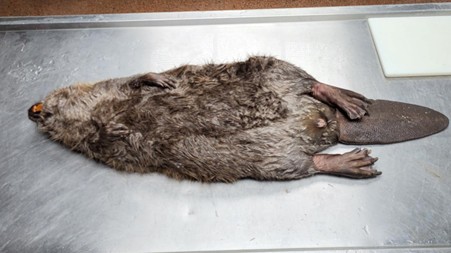

The year 2024, like 2023, had the beaver (Castor fiber) as the focus species of the DWHC. In 2024, a total of 38 dead beavers were reported to us, of which 8 beavers were collected for research. These included 7 female beavers and 1 male beaver. The beavers came from Gelderland, North-Brabant, North-Holland, Flevoland, and Groningen. In 2023, there were also 8 dead beavers collected, originating from North-Brabant, Gelderland, Flevoland, and Friesland. We want to thank everyone who reported and sent in these animals!

The leading cause of death among the examined beavers in both 2023 and 2024 was trauma, a collision with a vehicle being the most likely cause. In 2023, half of the examined beavers (4 out of 8) showed only signs of trauma (fractures, ruptures, and/or hemorrhages) without indications of underlying diseases that could increase the risk of trauma. However, one animal showed signs of poor mineralization of the ribs, and another had mild pneumonia caused by a worm infection.
In 2024, signs of trauma were observed in 5 of the 8 collected beavers. This year, underlying diseases that increased the likelihood of collisions with vehicles were found more frequently. For example, four of the beavers had inflammations of the liver, intestines, spleen, and meninges. In two of these beavers, bacteriological research showed a total of three types of bacteria: Escherichia coli, Clostridium perfringens, and Acinetobacter johnsonii. It is uncertain whether the bacteria C. perfringens and A. johnsonii were the actual cause of the liver inflammation or if they came from leakage from the intestines, as the animal had already been deceased for some time.

Two of the eight examined beavers stood out. The first was a beaver that died of suffocation, because it got stuck in a fence. During autopsy, superficial pulmonary hemorrhages and multiple hemorrhages with edema in the dorsal extensors were found. There was no evidence of underlying diseases in this animal. The owner of the fence immediately took measures and removed part of the fence.
The other notable case in 2023 was a beaver that died of a bacterial middle ear infection that had spread to induce inflammation in the brain and meninges. The inflammation was associated with, among other things, the bacteria Clostridium sp., Streptococcus agalactiae. This animal had also choked during death. The case was also notable because in 2018 a beaver had already been diagnosed with serious illness due to middle ear infection.
Furthermore, in January 2023, there was a beaver with pneumonia and kidney inflammation, and another beaver with mild pneumonia and an overfilled bladder. The causes of this could not be determined. Both had flukes (Stichorchis subtriquetrus) in the cecum, but no clinical problems. This worm has the beaver as its final host and many different snails as possible intermediate hosts. The worm is not pathogenic for the beaver under normal circumstances.
In July, a beaver that had been euthanized by a veterinarian was reported to the DWHC. The beaver had lost weight and had multiple illnesses, such as an abscess in the cheek. Bacteriological research was carried out on this, after which the bacteria Corynebacterium ulcerans was found. The abscess may have caused the animal to have difficulty eating and therefore losing weight. The animal also had joint inflammation and chronic inflammation in the feet with pus between the toes and a missing nail. Finally, the animal suffered from flystrike (myiasis) and ticks were found.
Myiasis is a serious condition and is mainly found in the summer, because of the many flies. They lay their eggs in the feces that stick to the body (for example diarrhea), or in the wounds of an animal. When the eggs hatch, the maggots can enter the body. (Sykes, Merkel & Little, 2021)
A beaver was examined in April which was found to be pregnant with four fetuses. The animal had a moderate liver inflammation, which may have contributed to the animal’s low fat reserves. The cause of death was culling. In May, a beaver was collected for examination. This animal died of heart failure, probably due to an underlying heart defect.
None of the beavers examined were found to have bird flu.
Banner © Edwin Giesbers
Literature
Sykes, J. E., Merkel, L., & Little, S. E. (2021). Myiasis. In Greene’s Infectious Diseases of the Dog and Cat (pp. 1347-1358). WB Saunders.